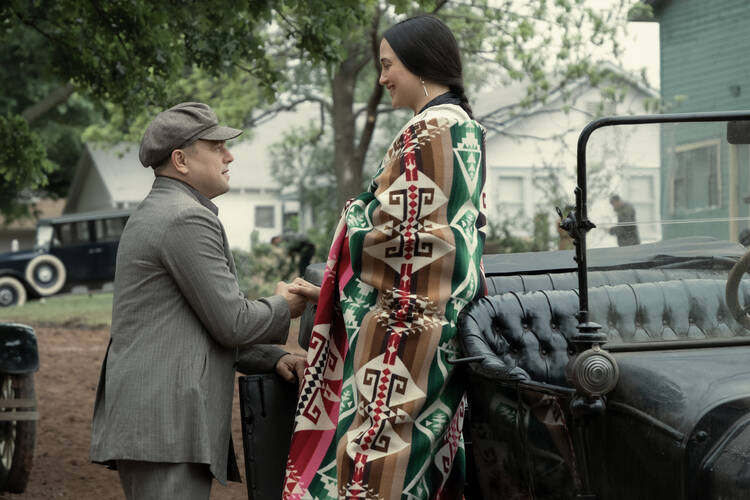Glazed in oil and blood and set to cook in a furnace of guilt and fury, “Killers of the Flower Moon” makes a case that 80 is the new 30: Martin Scorsese, the most prominent of American auteurs and champion of film history, continues as an octogenarian to explore and expand the possibilities of the medium and scour his own soul. He has created, with the sweep of grand opera, a film unlike anything he has ever done. At the same time, he has resumed, in a most exquisite manner, the rumination on evil that has informed much of his work—and that in this case refuses absolution for America’s original sins.
Based on David Grann’s 2017 nonfiction book, Killers of the Flower Moon: The Osage Murders and the Birth of the F.B.I., Scorsese’s three-and-a-half-hour adaptation, written with an epic collaborator, Eric Roth, is set in ‘20s Oklahoma at the moment that the Osage people, shuttled back and forth by the U.S. government, come to rest on land that gushes forth oil.
None of the perpetrators in "Killers of the Flower Moon" have the intelligence or imagination to consider that what they are doing is being done to human beings.
The moment is transcendent in its visual, visceral explosiveness, though the entire mood of “Killers” is one of foreboding. The Osage people begin dying via “accidents,” fires, blatant murder and a mysterious “wasting disease.” Fortunately for their survivors—who, often enough, are the white spouses of the dead women—the “headrights” to Osage Nation oil reverts to husbands—or to children whose mortality is no better guaranteed than that of their mothers.
Ostensibly a whodunit, “Killers of the Flower Moon” departs from the conventions of that genre by making the “who” quite obvious—even, eventually, to the Osage people being victimized. They live in “Indian Country” and thus have little recourse to justice, though some will be provided by the newly created Bureau of Investigation, as represented by the G-man played by a terrific Jesse Plemons.
The police-procedural aspects of “Killers” are exciting, and the imagery created by cinematographer Rodrigo Prieto is consistently breathtaking. But it is the slow creep of betrayal and casual murder that is the core of the film, and it begins the moment we, the audience, enter the narrative alongside Ernest Burkhart (Leonardo DiCaprio).
A World War I veteran just returned from France (given the 48-year-old and weathered-looking DiCaprio, it seems to have taken him a while), Ernest has a bad gut and no particular intellect. He intends to work with his uncle, William Hale (Robert DeNiro), a well-to-do cattle rancher and unquestioned authority on anything that happens in the town of Fairfax, Okla. Hale makes the point that his is the only land around without any oil under it, but he has nevertheless won the hearts of the Osage people, “the most beautiful people on Earth,” by building hospitals, libraries and a ballet school. He enlists his nephew Ernest—a nephew with criminal inclinations anyway—to help secure all the oil rights around them.
“Killers” departs from other Scorsese films in its lack of a center. A male center, at least. There is much in the film for those intrigued by Scorsese ephemera: DeNiro and DiCaprio, making their 10th and seventh appearance in a film by the director, are the ostensible stars and are appearing for the first time together in a Scorsese film (though they have co-starred in other productions).
It is probably beyond the point in this review that Lily Gladstone be mentioned, with exclamation points: Giving one of the more extraordinary performances of this or any other year, Gladstone plays Mollie Kyle, whose family is oil-rich, who will become Ernest’s wife and who will represent, in addition to a fathomless, inscrutable virtue, the point where greed and love collide and through whom Scorsese brings us to the brink of harrowing inhumanity.
The police-procedural aspects of “Killers” are exciting, and the imagery created by cinematographer Rodrigo Prieto is consistently breathtaking.
“Killers of the Flower Moon” may be the film for our time. In the past—in “Raging Bull,” with its various pathologies, or “Mean Streets” or “Goodfellas,” whose lovable ne’er-do-wells sprung from malignant environments—Scorsese gave his protagonists reasons for what they did. In “Killers,” the source of evil is willful ignorance or even rank stupidity, both of which are at the root of the racism that lay behind the murders in Osage County. None of the perpetrators have the intelligence or imagination to consider that what they are doing is being done to human beings.
Yes, the money-lust of someone like Hale has taken on a life of its own. But the starting point of all consideration among white Oklahomans is that the Osage rank below consideration. One of the remarkable things about “Killers of the Flower Moon” as it pertains to its place in the Scorsese oeuvre is that its “heroes” are nothing of the kind. Ernest represents the American as stooge; Hale is Manifest Destiny gone berserk; the white townsfolk are comfortable, passive onlookers to a horror show. It is all very familiar, if spectacularly eye-opening and stunningly beautiful.
As a film about crime, “Killers of the Flower Moon” will likely be compared to such autopsies of psychopathy as “Taxi Driver,” “The Departed” or even “Gangs of New York.” Still, I found myself thinking, too, of “Kundun” and “Silence,” Scorsese’s most overtly religious and elevating films, even if all his films are Catholic in origin. It is Gladstone, largely, who serves as our sherpa to a rarified destination of redemptive spirituality that Scorsese has mapped out across the oil- and blood-splattered dust of ‘20s Oklahoma. It is a damnable place, and unforgettable.
Correction, Oct. 23: This review incorrectly referred to Leonardo DiCaprio's character as Eugene Burkhart. The correct name is Ernest Burkhart.








